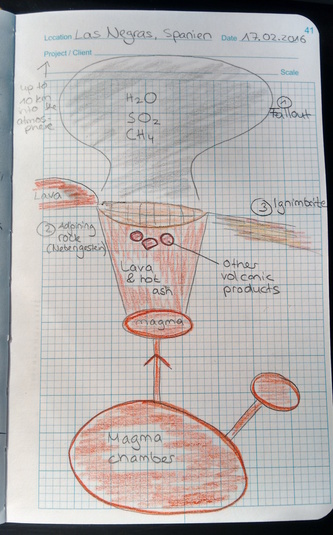Environmental Geology in Spain - Retracing a past volcanic eruption
21.02.2016
The rugged terrain of the Cabo de Gata-Níjar Natural Park in the South East of Spain has its origin in a volcanic eruption that occurred circa 7 million years ago. Our campsite near Las Negras was actually located on top of an ancient caldera, a volcanic crater, which is partly on land, partly in the Mediterranean Ocean. We were able to find four different products of the volcanic eruption in the proximity of our campsite. We drove to different outcrops, visible exposures of unconsolidated deposits at the surface, to see different layers. The eruption was an explosive one, comparable to the 1815 Tambora eruption, which was the largest eruption of the last millennium.
The principle of an eruption is similar to the incredible pressure of a pressure cooker. The reason for the pressure in case of the volcanic eruption is plate tectonics, which forces magma to climb up and to eventually reach its melting point. The eruption occurs when—metaphorically speaking—the lid of the cooker is taken away.

1) Fallout
An eruption cloud occurs during the eruption, as long as it is hot enough, it climbs up, but once it cools down, the cloud collapses, and all the particles fall down to Earth suddenly. As long as the magma chamber sends lava and ash up, the eruption continues. Air fallout deposits can be tuff, which are more porous, or tuffite, which are a bit denser.
An outcrop showing several layers of pyroclastic sediments
Here at this outcrop we can see various gradations of the joint plane, which is an indicator for a dynamic process. Several different pyroclastic sediments are visible at this outcrop: So-called volcanic bombs, which are bigger rocks, can be seen further up, while volcanic ash, and Lapilli, which is Latin for “little stones”, are visible at the bottom of the outcrop. The rocks look heterogeneous but they all originate from one phase of the eruption.
Water (H20) and sulfur dioxide (SO2) react to form sulfuric acid (H2SO4), which cannot be absorb, it can only reflect and refract, it can cause an albedo effect for up to three years after the eruption, the result is a cooling down of the Earth’s temperature.
2) Adjoining rock
Adjoining rock are rocks that have been at the site since prior to the volcanic eruption, for instance are they older volcanic rocks that were fragmented by the eruption.
3) Ignimbrite
Another product of the eruption is Ignimbrite, which consists of a high volume of driblets that solidifies to glass when cooling. Ignimbrite contains large amounts of materials from the inside of the volcano. Smaller crystals can came up from the inside of the volcano with the volcanic rocks.
Here you can see Ignimbrite, the orientation card is for scale and for directions
4) Alterations of pyroclastic products
Rock can show alterations, for instance bivalent iron turns black, trivalent iron turns red, and sulfur turns yellow.
Alteration of rocks, the book is only for reference of scale
If a volcano does not erupt, the magma stays in the magma chamber. The contents of the magma chamber come from further inside the Earth and can contain large amounts of gold, silver, and other ores, but usually its either one or the other.

